You’ve heard of green roofs and the value they add to the overall city climate, appearance, and well-being. But what then is a multifunctional roof? And why does it matter which one you choose?
In overpopulated cities, the need and desire for space is growing. Cities need vegetation, proper water storage systems, and sustainable energy obtained through solar panels. But where to put it all when there’s only so much space left? Just look up.
We spoke with Paul van Roosmalen, Programme Manager of Multifunctional Roofs at the Municipality of Rotterdam: “If you really want to find space for all urban challenges, climate-wise and others, densification, mobility and other things that are happening in cities, you will have to start combining functions, you will have to start looking at rooftops as a space where you can have multiple solutions,” says Paul, sharing with us all you need to know about multifunctional roofs.
What are Multifunctional Roofs
First of all, let’s get familiar with the term and the basics. Picture an upgraded green roof; a multifunctional one has the same layer of vegetation, but adds other functions to it too, making it increase in value, and in investment.
Gemeente Rotterdam differentiates and categorises seven different roof functions:
- Green roofs: provide vegetation
- Blue roofs: collect and store water
- Yellow roofs: provide sustainable energy (from the sun or wind)
- Red roofs: provide social functions (e.g. a bar or restaurant)
- Orange roofs: provide mobility (by connecting roofs or using them as platforms for flying drones)
- Purple roofs: are residential roofs (used mostly for tiny houses or rooftop villages)
- Grey roofs: are used for technical functions (e.g. antennas, window cleaning installations, air treatment installations)
According to Paul, a multifunctional roof is a roof with a combination of at least two of those colours or functions. The value increases when combining more functions, creating ‘golden’ combinations.
A good visual representation of said possible combinations can be seen in the computer drawings created by De Urbanisten for the Municipality of Rotterdam and the potential usage of their roofs:
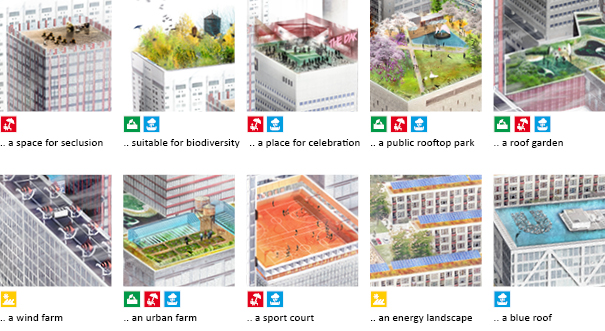
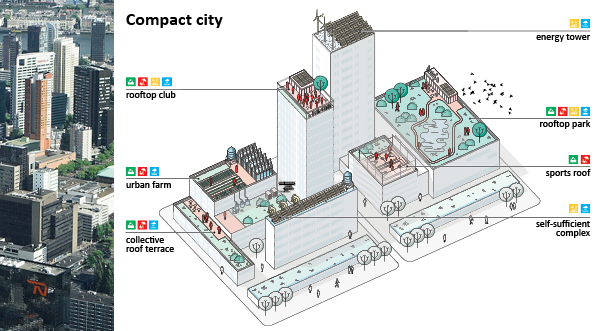
Additionally, Municipality of Rotterdam, MVRDV, and the Rotterdamse Dakendagen recently published the Rooftop Catalogue, showcasing all of the possible usages and combinations of functions for rooftops.
Benefits of Multifunctional Roofs
Many advantages come with installing a multifunctional roof; even just the implementation of green roofs has shown many benefits for the city and its residents – now imagine adding even more functions to the same roof. Noise reduction, aiding biodiversity, and air purification are just some of them. But four advantages are especially pivotal to Paul:
Space-Saving
“We always say that the solution to climate problems lies in cities; but it’s also the most difficult because you simply don’t have a lot of space left.”
Adding various functions to the same place helps effectively combat the lack of all that much needed and crucial space in the cities. Think of having plants, solar panels and a water management system on one roof, instead of using up three – one for every single function. It’s quite a difference when the city has thousands and thousands of perfectly eligible roofs.
Symbiosis of Functions
Functions combined will benefit from each other. Smart, or golden, combinations are the way to go.
Multifunctional roofs typically start with adding extra insulation and adding water storage follows, which works really well for adding plants on top of it. And on top of the vegetation layer come the solar panels. Before you know it, you have four or five functions in the same spot that actually benefit from each other. Solar panels have a higher energy production because of the cooler atmosphere from the vegetation, and the plants absorb the water from the water storage and vaporise it into the air. “This starts happening when you combine functions, and we try to combine them as much as possible,” explains Paul.
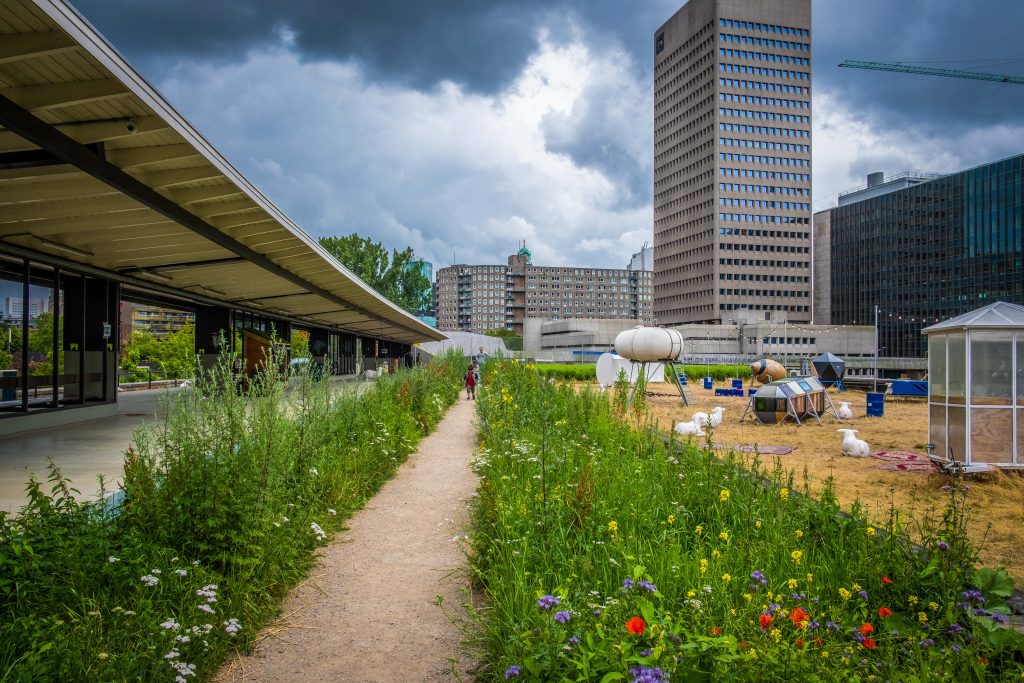
Helps the Business
In the current economy we always look for better returns on our investments. Combining the functions offers an opportunity to look into new business and investment models. For example, a building with a roof that is turned into a place where people can garden, starts making money. It adds property value to the building, while simultaneously tackling water issues, heat island effects, and the biodiversity crisis.
Aesthetics
A multifunctional roof will surely put the whole city into the ‘no regrets’ mentality. Not only do they attract nature back into the city, reduce the heat island effect, and contain water, they also generally look more beautiful than plain, traditional roofs. “I think we very often overlook that a lot of people live in towers that look onto lower buildings – multifunctional roofs are just simply more pretty, they make cities look more attractive.”
If you’re not convinced yet, more benefits can be seen in this chart:
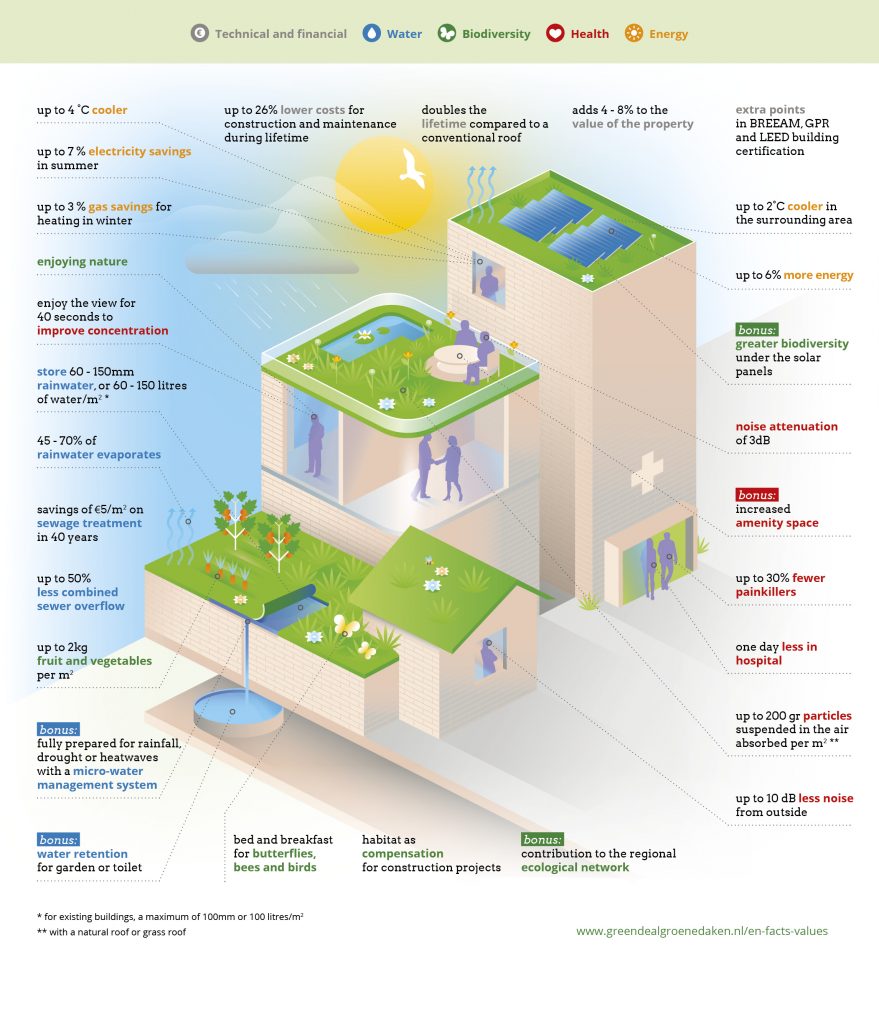
Challenges of Multifunctional Roofs
Of course, everything comes with its trials and obstacles. Even what seems to be the perfect solution, has its drawbacks. The ones to look out for regarding multifunctional roofs are:
Weight of the Roof
“The roofs were never meant to be used. They are meant to keep the weather out, they’re not meant for things or people to stay there” says Paul. When you start adding things like greenery on the roofs, you naturally start adding extra weight. And the construction is not always cut out for that.
Safety Issues & Regulations
If you bring people to the roof, you carry the risk of them falling off. And on a rooftop, it’s not easy to properly follow the required fire regulations. “We are using a space that was never meant to be used like that,” Paul adds, saying “all the regulations that we have, they’re designed for the past; and now we are starting to use the roofs for all kinds of things.” Regulations, laws, safety is where the struggle lies. “And it’s all doable, but at this moment, it still takes a lot of energy because we don’t have systems in place that accommodate these kinds of functions,” continues Paul.
Additionally, because solar panels represent a fire hazard, insurance companies have a big problem with insuring them on rooftops, “while the risks of climate change don’t seem to be taken into consideration. The systems in place often seem to be ‘penny wise, but pound foolish’.”
Transition
Green roofs are not a new thing. They have been present in the ancient Babylon and even in Nordic countries for centuries. They are, however, new in a sense of integration into a modern environment. “We’ve found a way to deal without greenery and water in cities, and now we see consequences of that – climate change being one. Now we have to bring them back to where they basically belong,” explains Paul. It’s retrofitting buildings in a way to make cities and the environment more balanced. “It’s a transition, it’s new – you always have a struggle when you try to implement something in a system that looks at it differently.”

How to Get People on Board
So how exactly do you get the residents to follow the multifunctional roofs trend? Paul suggests the following three steps:
1. Stimulation
If you start with making it a duty, people will riot. The best way to start is by encouragement through subsidy programmes, funding, etc., to try and help individuals take that first step.
2. Storytelling
Explain why it’s important to install multifunctional roofs, and how they can contribute to the well-being of the whole city.
3. Obligation
The last step is implementing the installation of multifunctional roofs into building codes, regulations, etc., just as it was done in the past with sewage systems and safety regulations.
The importance of motivating people can’t be stressed enough, make them want to do it. Following Paul’s guidelines, three things are necessary to achieve that:
- Show an Example
People need to see, hear, touch, smell multifunctional roofs. They need to really experience it. “It’s necessary because most people have no idea what can be done on a rooftop. When you look from the street up, you don’t even see it. You have to make a place available that people can visit and can start to understand what it means.” - Procure Ambassadors
People will more likely follow the advice of someone they know and trust, rather than what the government is telling them to do. Therefore, it’s good to get famous people, architects, shop owners, etc. on board, and hope that other residents will follow their example.
Following this step, also keep in mind designing a roof about which people are already excited. “Don’t necessarily try to do that one building that has the highest potential, but try to find a building where the stakeholders, the owner, the tenants, the surrounding neighbours are willing to make the change,” advises Paul. - Calculate
During the process, there’s always going to be someone taking care of the finances, and questioning what and in which amount it’s worth investing. And rightfully so, multifunctional roofs are not inexpensive. For that purpose, The Multifunctional Rooftops Tool from Arcadis, the municipality of Rotterdam and LIFE@Urban Roofs have created a useful tool for everyone to use for free to calculate the exact expenses and benefits of installation – you can access it here.
The Future
“Green will find its place on roofs, just as green found space on ground level in public space.”
All that being said, Paul believes multifunctional roofs are the future. One of the biggest challenges right now for cities all around the world is that more and more people are moving to them. And they need space – for working, for living, for recreation. Lack of space is becoming a problem. “I think that’s what we’re really trying to tackle most; we’re trying to add space to a city that doesn’t grow. Many cities around the world cannot expand, because there’s simply another city there or nature or a river or something valuable, and they don’t want to take it away to make the city grow.”
In this case, it makes sense for cities to resort to practically the only unused space: rooftops. “A logical way is to look up because there’s quite a lot of space there still.”
Paul argues greenery on roofs will be more at the forefront people’s minds than it used to be. In the past, cities were designed for cars, now the attention is turning to greenery and nature and truly creating a space for it. “And a good thing about rooftops is that you don’t have to compete with cars,” points out Paul.
One example of fully functioning multifunctional roofs is the Robert Fruinstraat street in Rotterdam, where roofs have been adapted to work together – two houses have a green roof, one a multifunctional one.
Roof, Roofs, Roofs – In a Nutshell
Multifunctional roofs present a way to produce sustainable energy, to use space effectively, to aid urban ecosystems, to retain water from downpours, to provide social space, and to contribute to the overall well-being of cities. The benefits outweigh the challenges. People might still need to be encouraged though – the best way to do it is through showing examples, informing about the necessity of multifunctional roof installations, finding representatives, and properly calculating the needed expenses and return on investment. With the creation of denser cities, roofs are the practical solution and the future of city-living.

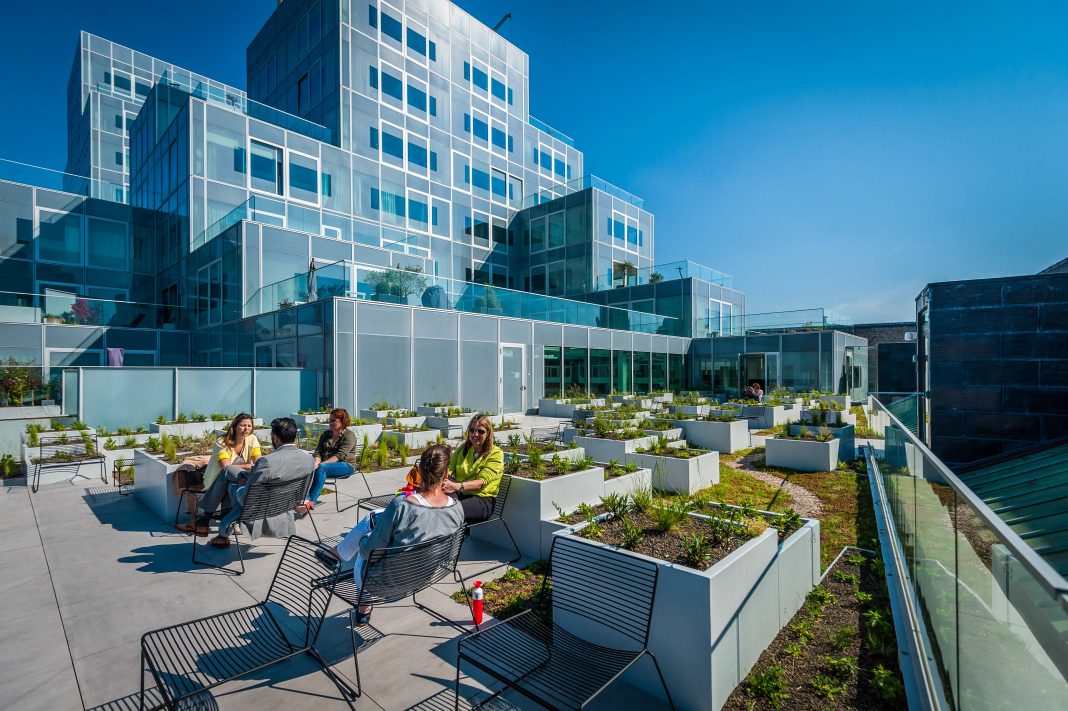


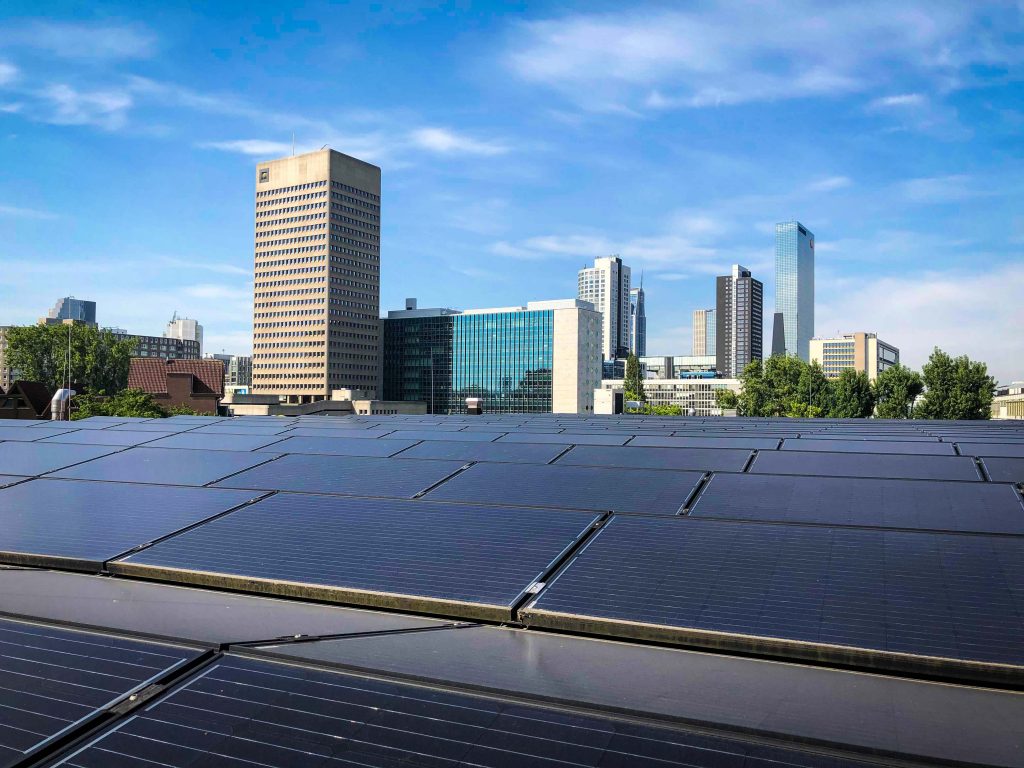
[…] Multifunctional Roofs & How to Implement Them in Your City […]
[…] Multifunctional Roofs & How to Implement Them in Your City […]